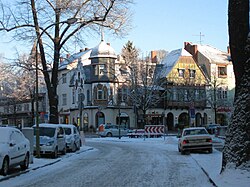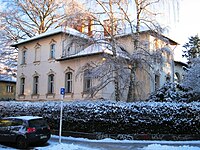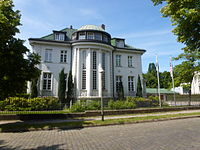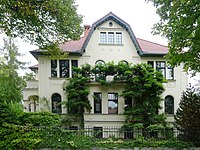
Steglitz-Zehlendorf is the sixth borough of Berlin, formed in Berlin's 2001 administrative reform by merging the former boroughs of Steglitz and Zehlendorf.
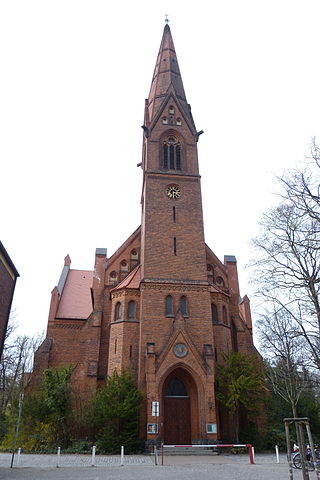
Zehlendorf is a locality within the borough of Steglitz-Zehlendorf in Berlin. Before Berlin's 2001 administrative reform Zehlendorf was a borough in its own right, consisting of the locality of Zehlendorf as well as Wannsee, Nikolassee and Dahlem. Zehlendorf contains some of the most remarked upon natural settings in Berlin, including parts of the Grunewald forest and the Schlachtensee, Krumme Lanke and Waldsee lakes. Additionally, it has large affluent residential neighborhoods, some with cobblestone streets and buildings that are over 100 years old.
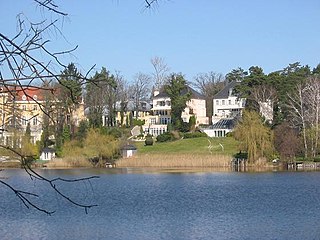
Grunewald is a locality within the Berlin borough of Charlottenburg-Wilmersdorf. Until 2001 administrative reform it was part of the former district of Wilmersdorf.

Breitenbachplatz is a Berlin U-Bahn station located in the Dahlem district on the U3.
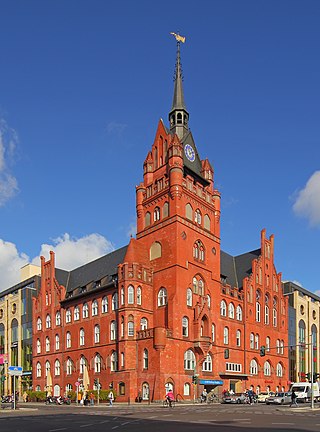
Steglitz is a locality of the Steglitz-Zehlendorf borough in Southwestern Berlin, the capital of Germany. Steglitz is a Slavic name for the European goldfinch, similar to the German Stieglitz.

Dahlem is a locality of the Steglitz-Zehlendorf borough in southwestern Berlin. Until Berlin's 2001 administrative reform it was a part of the former borough of Zehlendorf. It is located between the mansion settlements of Grunewald and Lichterfelde West.

Berlin-Lichterfelde West is a railway station in Lichterfelde West, within the district of Lichterfelde (Steglitz-Zehlendorf) in Berlin, Germany. It is served by the Berlin S-Bahn and several local bus lines.

Lichterfelde is a locality in the borough of Steglitz-Zehlendorf in Berlin, Germany. Until 2001 it was part of the former borough of Steglitz, along with Steglitz and Lankwitz. Lichterfelde is home to institutions like the Berlin Botanical Garden and Museum, the German Federal Intelligence Service (BND), the German Federal Archives and the Charité university hospital's Benjamin Franklin Campus. Many embassies and landmark-protected buildings are located in the affluent mansion settlement in Lichterfelde West.

Südende station is on the Anhalt Suburban Line in the former villa estate (Villenkolonie) of Südende in the suburb of Steglitz in the Berlin borough of Steglitz-Zehlendorf. It is served by S-Bahn line S25 and S-Bahn line S26. Its entrance is on the street of Steglitzer Damm.

Berlin-Lichterfelde Ost station is on the Anhalt Suburban Line in Lichterfelde in the Berlin borough of Steglitz-Zehlendorf. It is served by S-Bahn line S25, S-Bahn line S26, and Regional-Express lines 3, 4 and 5.

Berlin Osdorfer Straße station is a Berlin S-Bahn station on the Anhalt Suburban Line in Lichterfelde in the Berlin borough of Steglitz-Zehlendorf, which is served by S-Bahn line S25 and S-Bahn line S26. It was put into operation in 1998 and is thus one of the newest Berlin S-Bahn stations.
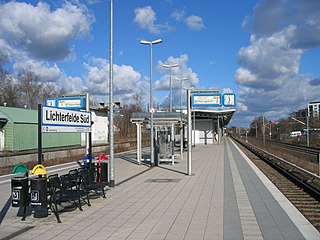
Berlin-Lichterfelde Süd station is a Berlin S-Bahn station on the Anhalt Suburban Line in Lichterfelde in the Berlin borough of Steglitz-Zehlendorf. The station was the southern terminus for S-Bahn trains on the Anhalt Suburban Line between 1943 and 1951, between 1961 and 1984 and between 1998 and 2005. From 1951 until the building of the Berlin Wall, services continued past the city limits to nearby Teltow. The station was closed between 1984 and 1998. Since 2005, the trains have run to Teltow Stadt.

Nikolassee is a locality (Ortsteil) of Berlin in the borough (Bezirk) of Steglitz-Zehlendorf, named after the small Nikolassee lake. Located in the affluent Southwest of the city, the area comprises parts of the Schlachtensee neighbourhood and the eastern shore of the Großer Wannsee lake with the large Strandbad Wannsee lido, as well as the islets of Schwanenwerder and Lindwerder.

Bus transport is the oldest public transport service in Berlin, the capital city of Germany, having been introduced in 1846. Since 1929, services have been operated by the Berlin Transport Company, although during the Cold War-era division of the city they operated in West Berlin only. In East Berlin the public transport agency split off from the BVG and rebranded as BVB, operating the buses in the Soviet sector of Berlin.

Lankwitz is a German locality (Ortsteil) within the borough (Bezirk) of Steglitz-Zehlendorf, Berlin. Until 2001 it was part of the former borough of Steglitz.

The Wannsee Railway is a suburban railway in Berlin running from Potsdamer Platz via the Ring line station of Schöneberg to Wannsee station on Großer Wannsee, a lake after which it is named. Today it is a section of the Berlin S-Bahn line S1.

Paul Louis Adolf Mebes was a German architect, architectural theorist and university professor.
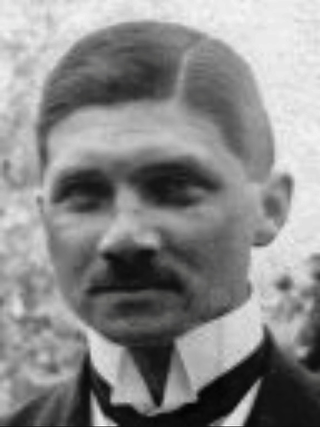
Bruno Ahrends (1878–1948), born as Bruno Arons, was an internationally known German architect, who worked in Berlin, Germany. He was a representative of Berlin Modernism Housing Estates before World War I and during Weimar Republic. Most of his creations today are under Cultural heritage management, some are part of a World Heritage Site.

The Dahlem Manor is an open-air museum for agriculture and food culture in southwestern Berlin. It is the historical manor of the former village of Dahlem. The manor has been in service for over 800 years.

Schlachtensee is a locality within the borough of Steglitz-Zehlendorf in Berlin. It was formed as a new administrative district in 2020, combining parts of the Nikolassee and Zehlendorf localities.
